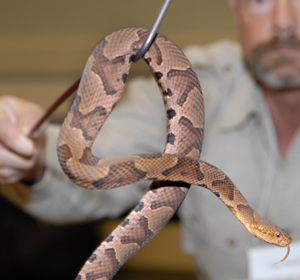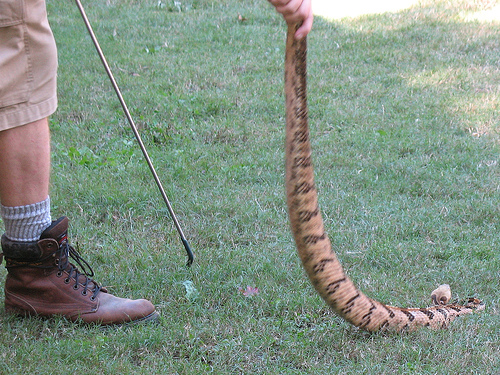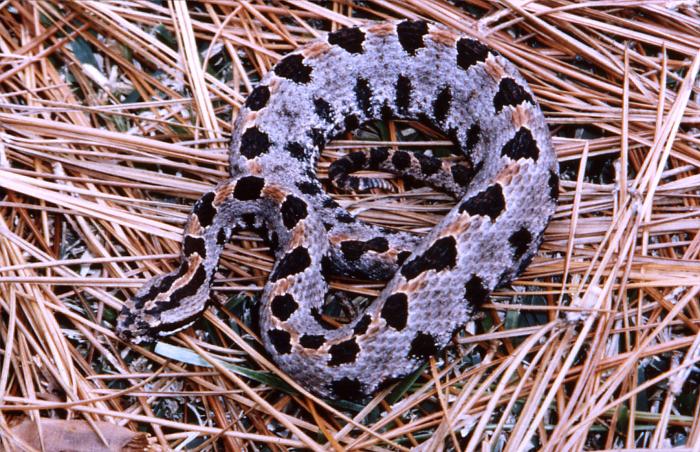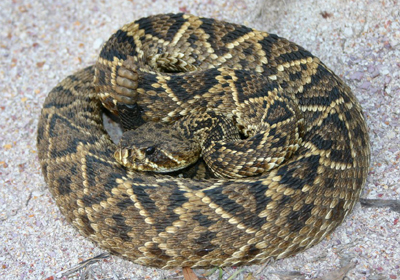Interesting Facts
Though large rattlesnakes are among the most dangerous snakes,
the timber rattlesnake can be an exception to this. They prefer
to stay out of sight and remain relatively quiet, and even when
they do emerge, they rarely demonstrate comb ative or aggressive
behavior. Unless provoked, they tend to slither away unseen,
but will not hesitate to fight back if they feel threatened
enough. In fact, death by humans from rattlesnake bites is far
less common than death by rattlesnakes from humans encroaching
on their territory. Most bites result from people actively
trying to handle the rattlesnake rather than just encountering
one out in the wild at random. Timber rattlesnakes have many
predators, including humans. Humans will hunt and kill
rattlesnakes simply out of ignorance, for sport, or for personal
benefits, like for food and their skins. They also cause harm
indirectly by encroaching on and
ative or aggressive
behavior. Unless provoked, they tend to slither away unseen,
but will not hesitate to fight back if they feel threatened
enough. In fact, death by humans from rattlesnake bites is far
less common than death by rattlesnakes from humans encroaching
on their territory. Most bites result from people actively
trying to handle the rattlesnake rather than just encountering
one out in the wild at random. Timber rattlesnakes have many
predators, including humans. Humans will hunt and kill
rattlesnakes simply out of ignorance, for sport, or for personal
benefits, like for food and their skins. They also cause harm
indirectly by encroaching on and
 destroying the rattlesnake’s
environment. Basically, human activity has led to a major
decline in the number of timber rattlesnakes present in their
geographical range. For these reasons, it is important for all
humans to acknowledge, respect and avoid these incredible
organisms at all costs in order to ensure their survival. It
would be a tremendous shame to watch their existence slowly disappear.
destroying the rattlesnake’s
environment. Basically, human activity has led to a major
decline in the number of timber rattlesnakes present in their
geographical range. For these reasons, it is important for all
humans to acknowledge, respect and avoid these incredible
organisms at all costs in order to ensure their survival. It
would be a tremendous shame to watch their existence slowly disappear.
If you do
come across a timber rattlesnake in the wild, try to stay at
least three feet away and do not approach it any closer. Also,
if an accident occurs and you do get close enough for a
rattlesnake to strike, do not try to treat the bite yourself.
This includes applying ice, cold packs, sprays, or alcohols to
the site of the bite because they usually just make it worse.
Instead call poison control and seek immediate medical attention
at a local hospital or clinic. The most important thing you can
do is to stay calm!
Below is a graph that
shows the decrease in the number of reported observations of
C. horridus over the course of 8 years:
I

Today, it is extremely important
to protect remaining populations of timber rattlesnakes for many reasons,
but there is one in particular that relates to humans. Over the years,
venom from pit vipers, like the timber rattlesnake, have proven to be quite
useful to humans for scientific research and development. In fact,
scientists have discovered many benefits of using viper venom for medicinal
purposes. Basically, snake venoms of all types are known to affect the
process of blood coagulation. Some venom, such as viper venom, inhibits the
blood clotting process while cobra venom does not. Instead, cobra venom
induces intravascular clotting so that the blood becomes thicker and
coagulates. This type of venom has been used to treat severe bleeding
associated with hemophilia. Viper venom, like that from C. horridus,
does the complete opposite. Therefore, rattlesnake bites cause profuse
bleeding and the blood to become thinner. For this reason, rattlesnake venom
has been used to treat patients with high blood pressure and heart disease.
Rattlesnake venom contains many enzymes, proteins and toxins that act on the
body in many different ways and provides a multitude of medically
significant chemicals. Other common effects of viper venom include blockage
of nerve impulses, shocking the heart, and the degeneration of flesh and
muscle. By preventing nerve impulses from transmitting from one to another,
the venom can reduce pain and possibly treat nerve disease such as epilepsy,
multiple sclerosis, and Parkinson’s disease. Viper venom has also been
tested to treat infectious diseases such as tetanus, hepatitis, and malaria
as well as vision disorders like cataracts. As you can see, timber
rattlesnakes are extremely useful to an assortment of organisms.
Due to diminishing
populations, timber rattlesnakes are relatively rare in the eastern areas
they inhabit, but they do share the region with some of their fellow
cousins: prairie rattlesnakes, eastern diamondback rattlesnakes and pygmy
rattlesnakes.


Pygmy rattlesnake
Diamondback rattlesnake
To find out more about keeping timber rattlesnakes AND yourself safe, visit this website from the U.S. Department of Agriculture Forest Service